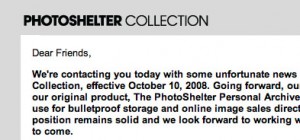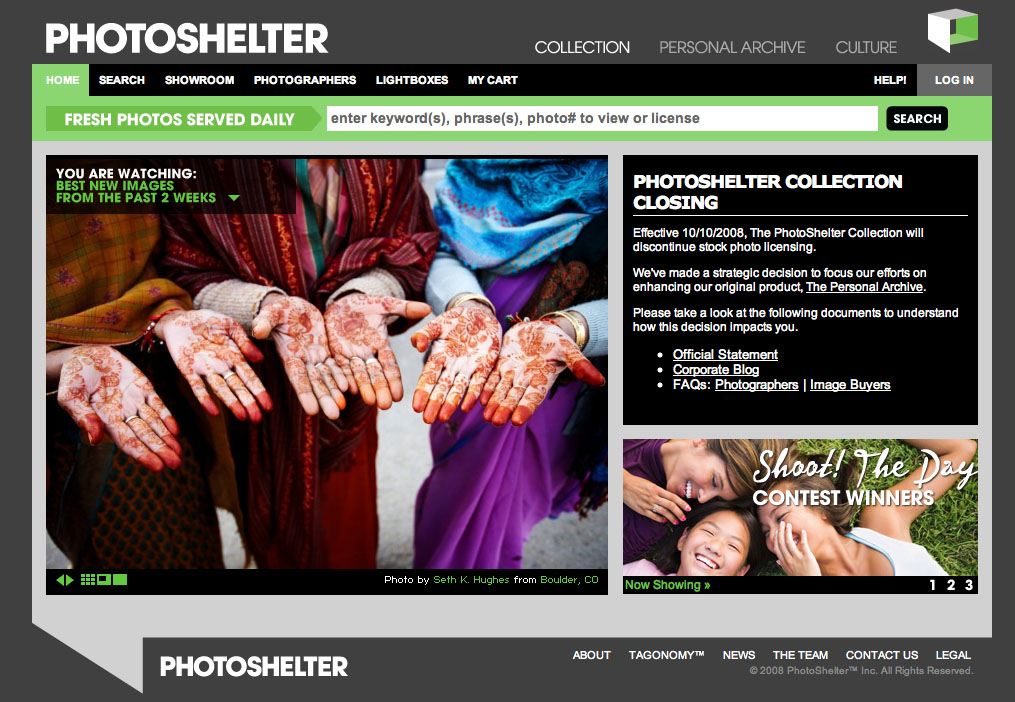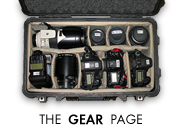Photoshelter Collection Comes to a Premature End
 Some things you just don’t see coming – and those really tend to sting the most – and leave a mark.
Some things you just don’t see coming – and those really tend to sting the most – and leave a mark.
The PhotoShelter Collection will leave a mark – and in more ways than one.
This morning, I received a personal call from Grover Sanschagrin, a friend and colleague of mine who was one of the founders of PhotoShelter and it’s “Collection.” He told me that the current market forces were forcing them to close down their ambitious “Collection” venture prematurely – while the parent company PhotoShelter and it’s Personal Archive is here to stay.
For those of you who may be unaware of the PhotoShelter Collection, this venture was a breath of (needed) fresh air in our industry. Their idea was to create one of the best high-quality photography collections out there – and to leverage new technologies in ways that would allow the photographers to keep a lion’s share of the profits from each sale (both commercial and editorial image sales.) Unlike most of their competitors – where getting less than 50% of each sale, and in fact where 30% to less than 5% of the total sale ever finding it’s way back to the photographer is unfortunately not an uncommon result – PhotoShelter made a point of “putting the photographers first” and giving them 70% of each sale. For those of you new to the business – that number is traditionally the amount that goes to the agency NOT the photographer – I just wanted to make that doubly clear.
The founders of the PhotoShelter Collection believed that by leveraging high-tech solutions – they could ensure that most of the profit went towards the artists who created those images – as opposed to some stockholder who didn’t give a rat’s ass about quality imagery – and was simply looking to “increase quarterly profits” and their stock’s share price…
And they embarked on this venture with intelligence, style, disciplined research, and a tremendous amount of positive energy and drive – with the help of some of the best staff I’ve seen at any agency I’ve worked with. Competing with the likes of Getty, Corbis, iStockPhoto and others is ambitious to say the least. Their battle was an uphill one – and we all knew it – but for those of us who joined their ranks – we all understood that in trying to help THEM succeed – we would in many ways be trying to help all of US succeed long term.
With events such as “Shoot The Day” and the publicity that surrounded that event – all looked to be going very well. But this morning’s phone call, and PhotoShelter’s decision was in many ways a barometer of what’s happening in the industry today.
I went to the PhotoShelter offices today to speak with some of the people (friends) I’ve known there for years and was able to speak with Allen Murabayashi – the company’s CEO. Allen confirmed that continuing on with the PhotoShelter Collection would have forced them to look for additional funding (which is not going to happen in this economy) or to start slashing the prices of photos and/or the percentages of what they would give photographers – which is not something they were willing to do. To his, and PhotoShelter’s credit – they chose to make this move to ensure that the PhotoShelter Personal Archive would be around long-term. This also is somewhat of a departure from the way most agencies have traditionally been managed: he and the management decided not to drive themselves into debt and go down in flames – and made the decision after numerous consultations to call it now, and keep the company afloat. After all – who needs yet another photo agency to go belly up due to bad business management?
While it was a personal blow for me to see this effort end prematurely – I also saw the bigger picture: this is a blow to our entire industry. It’s a blow to every photographer who has ever dared to challenge the idea that these mega agencies should get more than 50%-90% of each sale – derived from the work that photographers put their heart and soul into. It’s a blow for every photographer who ever wanted to fight “The Man” or the “Evil Empire.”
I won’t call out who plays the role of “Darth Vader” in this story – we all know who “he” or “it” is – and in fact many of my friends work there – so allow me to steer clear of that for now, as I in no way aim to tarnish them. What I will say is that “it” – referred to as the “incumbent player” in Photoshelter’s press release – has dealt yet another blow to our industry. It’s one thing to be the biggest and baddest in the business – and to become a monopoly by beating everyone else out fair and square – that need to “win” and be the “best” is what capitalism is based on afterall… survival of the fittest. But when one engages in business practices that not only help sow the seeds that may very well destroy the industry that one is part of – and perhaps even oneself – it’s hard to look favorably upon that company.
When I gave my images over to the PhotoShelter Collection – I knew that I was perhaps hampering my changes of making stock sales – at least initially – relative to giving those same images to the “incumbent player.” BUT IF FELT RIGHT. Sometimes you do things to benefit just you – at other times you try to do things that might somehow benefit everyone else in the industry along with you…
In the end – I think that what really hurt the PhotoShelter Collections chances, was that while they could compete toe to toe with the larger agency in terms of providing original content in a timely manner – and even remain competitive in terms of pricing – they could not match the “subscription prices” that the other “incumbent player” was engaging in. This “subscription pricing” – like microstock – is and will hurt us ALL. And we shouldn’t be surprised to see royalty checks coming from those that engage in that practice, that are the equivalent to less than a fraction of a percentage point of the total sales price that the same images would have garnered prior to this practice going into effect. Most of the imagery you’re seeing today – both rights managed imagery and royalty free images – end up in the publications you read as part of a “subscription” (i.e. the publications are paying for a feed of images – not per image. Which saves them a LOT of money – and takes it right out of the photographers’ pockets.)
While some may be quick to judge this premature demise of a good concept – and question it’s execution, I’d offer two things to consider: First, this was a carefully laid plan backed by a lot of research, and a lot was invested in getting good people to execute it. Ultimately you have to roll the dice to see if you can change the system – no venture is without risk. Second – while one may want to put the “best” imagery out there – sometimes “good enough” is “good enough” for the buyers out there… unfortunately. It’s hard to argue the value of an image – any image – when a bean counter is the one making the final (financial) decision.
Ultimately – the founders of PhotoShelter had to make a tough decision, given that the buyer behavior and market were not changing at a quick enough pace (which is not surprising, the photography market just isn’t “getting it” these days at all – and not embracing change) they had to chose to cut the cord now before this endeavor threatened the company as a whole. The good news is that PhotoShelter is healthy and plans to be around long term – their main business (as a place to store your valuable images online, and with tools to help you share them and sell them through a variety of avenues) is here to stay.
I do however feel very sorry for those that will invevitably be let go as a result of this downsizing – and for the disappearance of their “Shoot the Blog” venture that was written by one of the first full-time (paid) photo bloggers that I know of, Rachel Hulin. (Who is incidentally continuing on her own here.)
What is clear is that while the PhotoShelter Collection never fully achieved their ultimate goal of “Changing The Image Marketplace For Good,” as was their slogan – they sure made an impact on many of us, turned us into believers, and helped all of us realize that there is an alternative to the “evil empire” out there. While I, like many out there, may feel more pain than pride at this very moment – I hope that this was but the beginning of a trend that will continue to try and re-shape the photo industry.
The PhotoShelter Collection did indeed leave a mark – and I expect the PhotoShelter Personal Archive to continue in that direction from hereon out.
N.B.: On another note, Corbis laid off 16% of it’s workforce today… 175 people. And to find out more about Photoshelter’s plans and FAQs go here.















I was shocked by the e-mail this morning. I felt Photoshelter was that breath of fresh air are industry needs, too.
While I loved the ideas and ideals of PSC, I wonder now as an armchair quarterback if their initial leap was far to big. I eagerly signed on to contribute and was in the final stages of preparing a very large submission. I am a current personal archive user. And will likely expand my use of that service.
I still am active with a very small editorial agency that has done handsomely over the 15 years or so I have been involved with it. I’ve had a few big ad sales, but it’s been the “tortoise” of the race in the stock photo business, sticking to it’s niche, and as a result it has done quite well for me.
Could PSC have done better by not trying to change the whole stock photo industry and instead have, say, become a really great editorial agency to start?
With all the monopolization, consolidation and decimation of the markets for professional photography, attacking the problem niche by niche may have been better. Or is creating the infrastructure to become a new agency so cost prohibitive that you have to shoot for the moon?
I lost my full time staff job of 24 years and have little if any respect for the direction of most remaining modern photojournalism outlets. I applaud the good fight still being waged by many of my brethren. I thankfully have my small agency to hold on to. However with the death of PSC I fear the stock photo business is dying just like newspaper photojournalism.
Are we destined to become an industry like that of actors? I fear the photography business soon will be populated by a few gazillionaires who are intensely creative (or fashionable) and a gazillion wanna-be’s sitting on the stool at the soda fountain, willing to sell their souls for a single opportunity to be creative.
I too was greatly saddened by their e-mail. I was at the launch in nyc last september and was truly excited and hopeful for the future of this stock agency. They are a great group and I thank them for their efforts and wish them future success in their ventures and with the archives.
Mitch – you bring for very good questions.
I’m not sure the issue was whether or not they had the funding or not to last two years… when you enter into any agreement with Venture Capitalists or pretty much any investor these days – your funding is contingent on your rate of growth…
So even though you may be growing – and doing great – it may just NOT BE ENOUGH for the VC or investor…
No matter how good your research or planning – there’s one thing that’s impossible to predict – and that’s the rate of growth ahead of time… setting targets is tough enough (not to mention meeting them) but predicting a rate of growth is close to impossible.
I’ve read quite a few comments on the internet from people who are upset at all of the time they put into keywording, captioning, and preparing their files for the PhotoShelter Collection – and feel it’s all been a “waste of time.” I’d counter that it was far from a waste of time as you’re now likely much close to submitting those images to just about anyone else.
I wrote to Allen and Grover a moment ago to thank them for accepting me as a PhotoShelter photographer back in February. As a semi-professional with a reliable day job, I think my demographic is the real threat to the market because so many talented amateurs who don’t have to rely on their photos as their livelihood are willing to give their work over to microstock agencies or for free on Flickr…mostly just because its a kick. That’s the danger. It undermines the market for all of us and diminishes the value of all imagery.
PhotoShelter also had a tagline: “the coolest photographers you’ve never heard of.” That was me. A new-comer with no reputation who was just getting the confidence to go for it, and they accepted me. Corbis, Getty, Masterfile, Lonely Planet Images … they never would have even opened the door. What I learned in the first month alone was invaluable, let alone the time since then. Allen and Grover set up a business that schooled me on the market and gave me the confidence to value my imagery. PSC did have that impact on a few of us, so it was absolutely worth it. Where will I go now? You can be assured I won’t be applying to iStock anytime soon. To bastardize a line from Hillary Clinton: “No way, no how, no microstock.”
I’m a better photographer because of the experience. Where I go now is uncertain, but I thank them for the ride. These are tough times. Hopefully when the economy rebounds, there will be some way for an ambitious outfit like PSC to carve out its niche and succeed.
You said it absolutely right Vincent. This is a bad day for stock. Photoshelter have done the honourable thing so they could live to fight another day. I am actually with Digital Railroad which share the same philosophy regarding fighting the big bad wolf that is the incumbent player. I hope both organisations can carry on and change the business for the better. It definitely needs it. The best way for photographers to help Photoshelter is to be doubly active in marketing their own archives from now on and therefore increase PSs presence. On DRR I sadly see a lot of archives that have been half heartedly put together and or then neglected. People seem to think that it will do the work for them which just isn’t the case. We have to work twice as hard as the next guy to get our images out there and compete.
Another reason to blog!!
Regards. Patrick.
I wonder aloud (but there’s no one to hear me) if some of the blame has to be placed on the photographers that use the incumbent’s services? If a large majority had used Photoshelter Collections, then buyers of the images would look there for the images they needed.
Perhaps it’s a bit of a “we’ve never done it like that before” whereas buyers are comfortable with buying from the other stock agencies and not as much with Photoshelter.
Regardless, I am saddened to see this happen.
I must say that PSC did this to themselves in a fashion by being too picky in some of the imagery they were willing to accept. I know a photographer who does extremely well in Macro that had highly marketable images rejected in favor of things that were more un-traditional. Essentially they turned away a lot of revenue and got a shaky reputation as snobbish or elitist.
That said, they will be missed and their core cause was indeed a noble one.
Very well written post! The question remains however….what is the answer to all of this? There must be a happy medium somewhere. Somebody just needs to figure it out. I think Photoshelter’s ultimate demise was that they were too idealistic regarding photographers and underestimated the general greed associated in the stock industry. Their formula would have worked if everyone appreciated the opportunity and uploaded to them exclusively giving them a unique portfolio that would and could compete with the big dogs. There was virtually no chance of that ever happening. It seems the majority of photographers find spreading their portfolio thoughout all the sites is the best way to go which leads buyers to simply search for the cheapest option available and why not? They are getting the same photo’s.
OMG!! This and Sarah Palin too?!! It’s too much to take in so short a time!
Beth
Vince, thanks for this. My one question: How do you handle rights to resell pictures through Photoshelter of 1) pro sports and 2)stuff you shot for the Times, like the skaters in Times Square. I was just surprised that you could resell them. And I am interested in finding ways to market my stuff that I’ve done as a newspaper staffer. Thanks!
James
While I admire Photoshelter in their efforts, and found them to be very nice and honest people to deal with, I disagree with the analysis that big, bad Getty Images did them in (full disclosure: I have images placed with Getty).
I believe Photoshelter can only blame themselves for their own demise. Their vision was flawed from the beginning, and their strategy was non-existent and/or very poorly executed.
1) Photoshelter started this venture without even a basic understanding of the stock photography market. The kind of imagery they were promoting in the beginning could not be found in any good collection – with good reason. It just wasn’t very marketable.
2) Instead of focusing on building a quality library that would attract buyers, they chose to accept almost anything, and did a misguided effort to educate even rank amateurs on how to take a marketable photo.
3) Instead of gradually investing in the business for the long term, they throw a mountain of money at their effort at the start, culminating in a massive “Shoot the day” effort just months before running out of money. I can only ask: what were they thinking?
Even their demise is a complete disaster – leaving thousands of photographers stranded and doing more damage to the industry they were trying to help!
And the sad thing is, they went under just as they were starting to recover from the mistakes they made in the beginning! If there is anything you need in order to succeed in Stock Photography – it is patience. It takes time to build an image library, it takes time to market and sell them, and it takes time to learn what the market wants.
The idea that you can create a viable stock photography business in 12 months is ludicrous.
I feel that Fabian Gonzales has summed this PSC debacle perfectly. The only thing he left out is the totally crass insensitivity of making the announcement on 9/11, while they were reading the names.
To my opinion PSC made 2 mistakes which lead to their demise:
1) They started the business with the focus on the photographers, but forgot that it takes two to make a deal. There are no obvious advantages for the buyers, like microstock (small prices) or macrostock (services to find the perfect photo and negotiating between buyer and seller). This was their biggest flaw.
2) Their change in terms where no microstock images weren’t allowed anymore alienated contributors. The photographers are the owners of the photos, so why did PSC decide they had the right to tell photographers where to sell their photos?
jivz,
They didn’t tell photographers where they could or could not sell their photos, simply that they didn’t want to be associated with microstock photos (I’m sure a fair amount of people broke the rule anyways). Think of it like a minimum dress code for a nice restaurant/event/wedding/etc; they aren’t (weren’t) saying you can’t come in, just that you should act in a certain (professional) way in regards to ones photos.
If one wants to sell photos for cheap prices, fine. But don’t come to a place where others are trying to sell for a fair price and want in on the action to try and make an extra buck while diluting the whole collection with stuff that can be bought on the cheap. If BMW stuck their logo on a Ford and tried to sell it for $60k, it would still be a cheap-o ford that one could get for $20k, buyers know this. And microstockers complaining that they can’t sell their photos on “macro” agencies is sort of like shopping at Walmart and then complaining that there are no more ‘mom & pop’ shops left anymore when you want one on a rare occasion.
And I don’t think it was ever their intention to compete on price, so why would they want their collection to be a mirror of Istock and have themselves be the 10th-11th-12th agency that some microstocker submits to. They should have gone the exclusive route.
I’d like to know more specifics about the “subscription prices” mentioned. Are there any facts or figures available or is each deal negotiated individually?
As well as all the other comments it became obvious that PSC didn’t know how to sell/contstruct EULAs. More than one client/tog has made this comment that clients got fed up with PSCs seeming inability to service clients and moved their business either direct to the tog or more probably elsewhere.
Employing people who knew the workings of the business was perhaps a greater need than paying for someone to rip-off (sorry ‘fair use’) other’s work on a blog. Even more stupid to ‘fair use’ the work of a Getty tog who has shot promo work for their (Getty) home page….duh!
PSC can’t say they weren’t warned about their short-sightedness, it was plastered all over their forum…they just chose to ignore the warnings. Thankfully like many I left before the curtain closed.
And yes, I have work with their enemy…….
i was so bummed when i got the e-mail from photoshelter that they were shutting down.
SEO ZONE is a search engine optimization(seo) firm, provides seo, seo article, seo tools,seo news and seo related informations,helping companies leverage the internet to increase revenues and profits.
Search engine optimization (SEO) is to improve the homepage so that its own WEB site is displayed in the high rank when the retrieval is put by the key word and the key 葬儀 相談 phrase that relates to the content of the homepage in the search engine called Google, Yahoo, and MSN.
quite useful. thank your for your efforts.
hello!こ
kkkkkkkんにちは!
あああああ
あああああああ
ああ
こんばんは
konnichiha
こんにちは!長谷川興産 靴専科がお薦め!!
Great post thanks for tehs hare!
Hi I discovered this website in error while i was searching yahoo due to this issue, I can say your site is really helpful I additionally love the theme, its amazing!. I dont have a whole lot of time for it to read your entire post right now but We’ve bookmarked it and as well opted in for your RSS feeds. I’ll be back a couple of days. many thanks a fantastic site.
i was so bummed when i got the e-mail from photoshelter that they were shutting down.
Utterly pent subject material, Really enjoyed reading through.